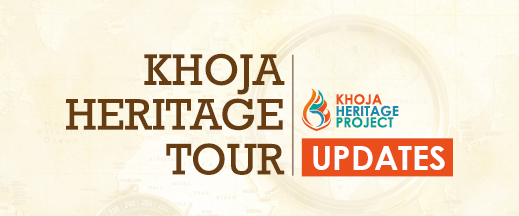The World Federation is pleased to share with you the CoEJ nominations submitted to us by you! Click here to find out who our community nominated for Fatima Inspires 2019.

<< Go Back to Khoja Heritage Tour Main Page
The Khoja Heritage tour took place between the 20th to 30th December 2018.
Read about how the daily blog below to find out what the participants enjoyed the most throughout their tour.
Day 1: 21st December, Friday
Our first day on the tour began on a high very note. The participants were thrilled as one could unmistakably notice the enthusiasm and excitement of creating bonds and making acquaintances. Waiting for Uber to arrive, everyone was introducing each other with typical Khoja questions, from which Jamat do you come? as if ethic background prevailed over nationality and citizenship! Visiting Mulla Qadar Mehfil, the pioneering institution for the nascent KSI community, was the first item on the itinerary.
The opening ceremony covered introduction of the participants, deliberating on the objectives of the tour and most importantly, reflecting on the history and contributions of this relentless preacher of the late nineteenth century. As the session ended, the participants generated further conversations and debates about the events unfolded during his time.
The group is small but diverse. The youngest participant is a baby girl of 5 months and the eldest around 70. It is all about connecting with the roots and walking on the lands where our ancestors once used to walk. The narrow street of Khoja Mohalla still contains the aura of the trade and commerce. The walk in the streets was a perfect translation of the deliberation held at Mulla Qadar Madrasa.
The Sunni, Ismaili and Ithna Asheries religious and cultural institutions in the vicinity of each is the reminiscent of the shared heritage of 14th to 19th century. We were fortunate to pray Jumma prayers in Khoja Masjid and Maghrib prayers in Mughal Masjid.
The Indian gourmet meal and chit chat on the dinner tables played its part in winding a rather long day.
Day 2: 22nd December, Saturday
The day began with visiting Hasnabad; burial place of the 46th Imam of the Ismaili Shias who is buried there along with his few other family members. This was followed by visiting Aarambaug, the KSI cemetery. Asad Virani and Dr. Sadiq Uttanwala offered a detailed explanation of this historic kabrastan and the luminaries resting at this place. The gathering hosted Dr. Asgar Moledina, former President and current councilor of the World Federation, who spoke on the importance of community heritage.
Various court cases of the community from 1829 to 1866 were discussed in an interactive session led by Shaykh Kumail Rajani. Participants took time to recite fateha and Sura Yasin for the marhumeen.
After namaz and lunch, the weather was perfect for a boat ride at the Gateway of India; resembling the British architect erected in the honour of King George V. The glittering water of the sea and late afternoon sun of December proved to be perfect combination for a boat ride. The highlight of the day was the reflection session which formed the base for an engaging debate on the preservation of Gujarati language.
Day 3: 23rd December, Sunday
The day was the day of journey. After a heavy Indian breakfast, the tour headed towards the airport for a domestic flight to Bhuj. Everyone was excited, especially those whose ancestors hailed from Kutch. One would chat about Mundra and other would enquire on Kera.
We landed in Bhuj late afternoon where a coach was ready to drop us at our traditional exotic Kutchi resort. The participants thoroughly enjoyed the sunset view from outside their rooms; which were located on a hill top while sipping their evening tea.
The Kutch Federation organized a wonderful community program where the participants got an excellent opportunity to meet the community members from Bhuj, Kera, Nagalpur, Mundra and Mandvi. Rajabbhai Hassam, the president of Kutch Federation expressed his emotions stating, ‘It is indeed an absolute pleasure to receive community members from different parts of the world and it is this religious and cultural bond of Khoja Community which has tied together’. The ceremony included presenting flowers and Imam Zamin followed by homemade desi dinner. Jafferbhai Manek from Eastbourne, UK commented, ‘The warmness, the simplicity, the aura of this land and its beautiful culture is undeniably captivating’.
Day 4: 24th December, Monday
The morning of the 4th day of the tour was dedicated to explore the history and culture of Kutch. They say, ‘Kutch nahi dekha to Kuch nahi dekha’ (If you haven’t explored Kutch, you haven’t explored anything’. The day commenced with a visit to the historic Kutch Museum and Aina Mahel. Kutch Museum is the oldest Museum of Gujarat exhibiting the largest existing collection of inscriptions dating back to the 1st century CE.
A section of the museum is devoted to tribal cultures, with many examples of ancient artefacts, folk arts and crafts and information about tribal peoples. The museum also exhibits embroidery, paintings, arms, musical instruments, sculpture and precious metalwork.
The Aina Mahal is a 18th -century palace constructed with marble walls and adorned with bronze lace and glass.
En route to Kera, we stopped by an eye hospital which was built by a community member, Seth Jafferbhai Rehmatullah, in the year 1895 and it was the first hospital in the entire regions at that time.
Our next stop was the monumental white tomb of Peer Gulamali Shah, a 15th century mystic saint. The sight is not only an elegant masterpiece of architecture but also reminiscent of asceticism and esoteric teachings of the religion. The ambience of the place can’t help but to reflect and ponder on the meaning of life and how one has to strive to meet One. Rajabbhai Hassam provided a brief history of the Peer, his mission and contribution to the conversion of people towards the right path.
To understand the sophistication of perilous journey of the forefathers in dhows, the tour organised a visit to ship building industry in Mandvi where we got to learn how a dhow is made and how much days it would take for a person to travel from Mandvi to Bagamoyo in the mid-19th century. We also got an opportunity to embark on a ship to explore what goods they carry for the journey of several weeks in waters.
Participants were delighted to witness another setting of sun in its full glory, painting a gorgeous sky, leaving us to observe and enchant 'Subhallah'.
The day ended with visiting Mandvi jamat where we conducted a small majlis of Imam Husayn (as) followed by fateha dinner.
Day 5: 25th December, Tuesday
After several days of visiting historic sites and discussing Khoja history and culture, day 5th was exclusively dedicated for recreational activities; visiting Rakshak wan, Kalo dungar and White Rann of Kutch. We were accompanied by the children from the boarding school of Bhuj and several other community members.
Our tour guide Bharatbhai explained the itinerary of the day, highlighting the historic background of the paces we were supposed to visit throughout the day. The first stop was Rakshak Wan; an artificial forest exhibiting several cultural aspects of Kutch tradition. The participants enjoyed strolling around in the surprisingly pleasant weather taking some selfies and group photos. The next stop was at Kalo Dungar (Black Hill), a landscape which is the highest point in Kutch, Gujarat more than 450 meters above the sea level. The view from Kalo Dungar is breathtaking. The magnificent plains of Kutch with an incredible terrain is a perfect combination to ponder on nature’s untouched beauty. Some of us took a camel ride to the top others resorted to hiking.
After visiting Kalo Dungar, it was the time for salat and lunch at a local restaurant. Thousands of people visit Kutch every year to take part in the three-month long festival of Great Rann of Kutch, a salt marsh located in the That Desert of Kutch which was our next stop.
The white salt spread over the entire Rann made the desert look like it has wrapped a gigantic white shawl over the entire region. Some of us enjoyed watching Kutchi folks engaged in displaying their cultural heritage whilst other preferred to experience a walk on the white desert. The sunset down but then the beauty of the desert in the glowing moon is all a different experience. We were lucky enough to witness both on the same day!
Day 6: 26th December, Wednesday
The next lag of journey entailed an 8-hour coach journey to Amreli, the resting place of the great community historian Marhum Edalji Dhanji Kaba. This 19th and early 20th century scholar has immensely contributed to the community history as to his credit are some 50 translation and independent works and some 100 articles. His unparallel contribution remains valuable to the date as a reference point for all the historians to analyse the events folded in that critical period of the Khoja community. Shaykh Kumail Rajani presented a detailed summary of his life and works. One could not fail to notice his cry while explaining the importance of his works, on the fact that such scholars are under appreciated and their contribution remains unexplored. After reciting fateha on his burial place and praying our maghrib salat, the journey continued towards Bhavnagar.
We made the best usage of our time in coach discussing history, sharing our thoughts on various cultural issues, narrating stories of our families and much more.
Day 7: 27th December, Thursday
While in Bhavnagar, we visited Allama Haji Naji's burial place in the community cemetery. Shaykh Kumail Rajani briefed us about the life and contributions of Haji Naji Saheb. His collection of dua was the mafatih al-jinan for every Khoja household. His books on akhlaq, history, fiqh, tafseer of Qur’an were widely discussed in his presentation.
The itinerary included a visit to the countryside of Gujarat to catch the glimpses of the village life. Vartej is a small village near Bhavnagar. We visited the place to connect with the community members and also to have an insight into their lives. After the welcome speeches, we had an interaction with the youths and got to know about their views on education and the challenges they faced in their countryside life
In the evening, we got chance to recite the translation of Dua e Kumail in Gujarati followed by an incredible meeting with some youths of Bhavnagar. The meeting which lasted for two hours changed our perception in respect to the enormous talent hidden in this part of the world. One youth in his 20s established an academy employing 20 teachers. The other youth was a successful entrepreneur responsible for running a multi-national company. Some had their own consultancy firms and others were studying medicine. The credit goes to the community institutions who provided resources for these youths to pursue their careers and shine in their respective fields.
Day 8: 28th December, Friday
The 8th day of the tour commenced with visiting Umme Kulsum Trust managed by Parveen Bahen, a volunteer responsible for running several welfare institutions. The Umme Kulsum Trust runs an old age home, a place for the differently abled, a Hawza for girls, and many other institutions working under one banner. We visited the house of the differently abled people where Parveen Aunty briefed us on how these institutions function with the help of various voluntary workers.
While the men participated in the juma namaz of the jamat, the women participants visited another center of Umme Kulsum Trust meeting many other community women engaged in various domestic occupations.
After lunch, we headed towards Ahmedabad in a 4-hour coach journey.
Day 9: 28th December, Saturday
Our trip commenced with visiting Mulla Qadar Mehfil in Mumbai and ended with visiting Pirana, the burial place of Peer Imam Shah, the founder of an eclectic sect of Satpanth (the true path).
If local legend is to be believed the Dargah is as old as Ahmedabad city. The thread that has kept the villagers together for more than 550 years is the dargah of Hazrat Imamshah a Sufi saint revered by both Muslims and Hindus. Moreover, Satpanthis, as the believers of the sect are called, follow various practices which indicate the confluence of both Hindu and Islamic rituals. A local priest and care taker of the dargah gave us an insight into their belief system. We were told that Imam Ali is an avatar of Lord Vishnu and that a saviour named Kalki (another avatar of Lord Vishnu) will appear at the end of time. Drawing parallels, he continued saying that Muslims refers to that saviour by the name of Mahdi.
Participants were both shocked and surprised to see how Satpanth tradition intertwined the tenets of Hinduism and Islam. The faith of the early Khojas, a caste distinction, is believed to have been Satpanth before getting identified as more defined identities of Ismailis or Ithna Asheris.
The Zohr and Asr prayers were recited at KSI mosque followed by lunch. The day ended with the closing ceremony to not only bid farewell to each other but also reflecting on our Khoja Heritage tour, sharing feedback, presenting vote of thanks with the tears of joy and gratitude.

Related News
Related News
The World Federation is pleased to share with you the nominations submitted to us by you! Click here to find out who our community nominated for Fatima Inspires 2018.










